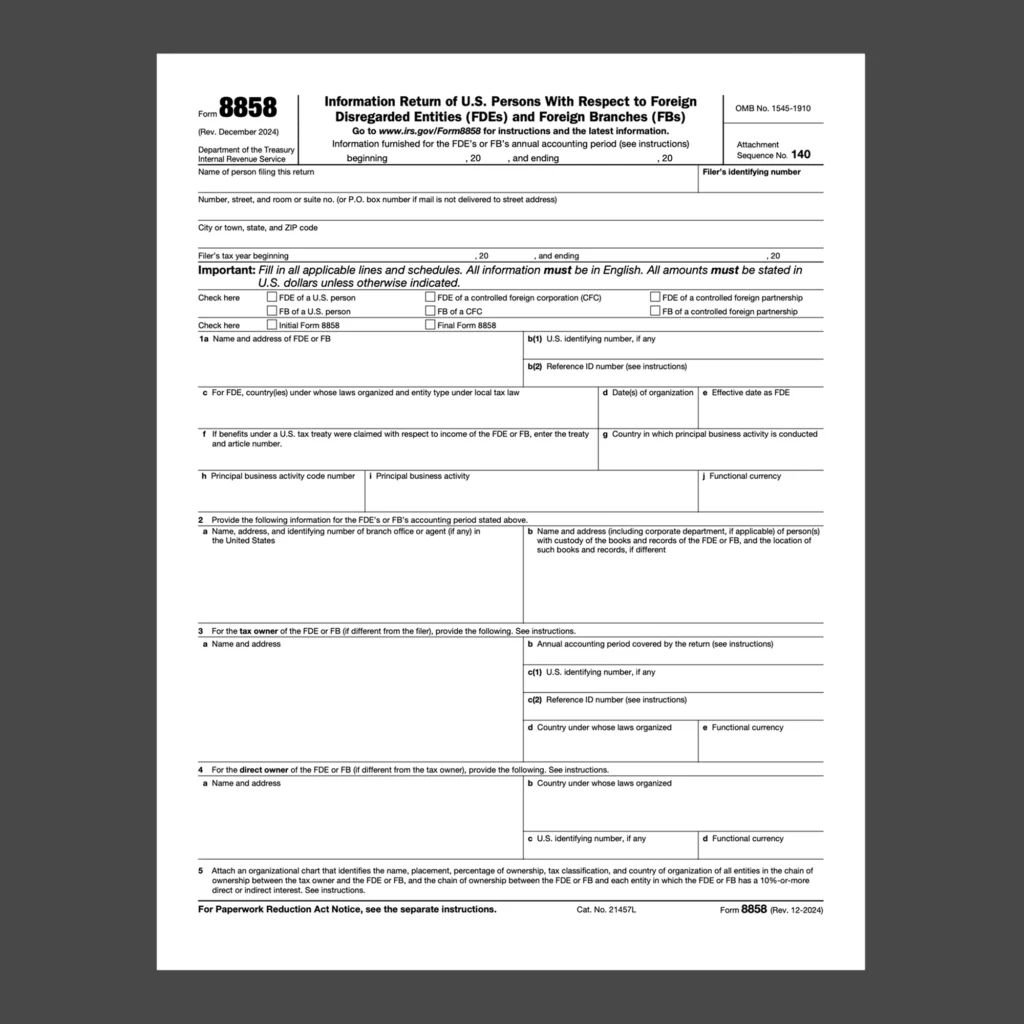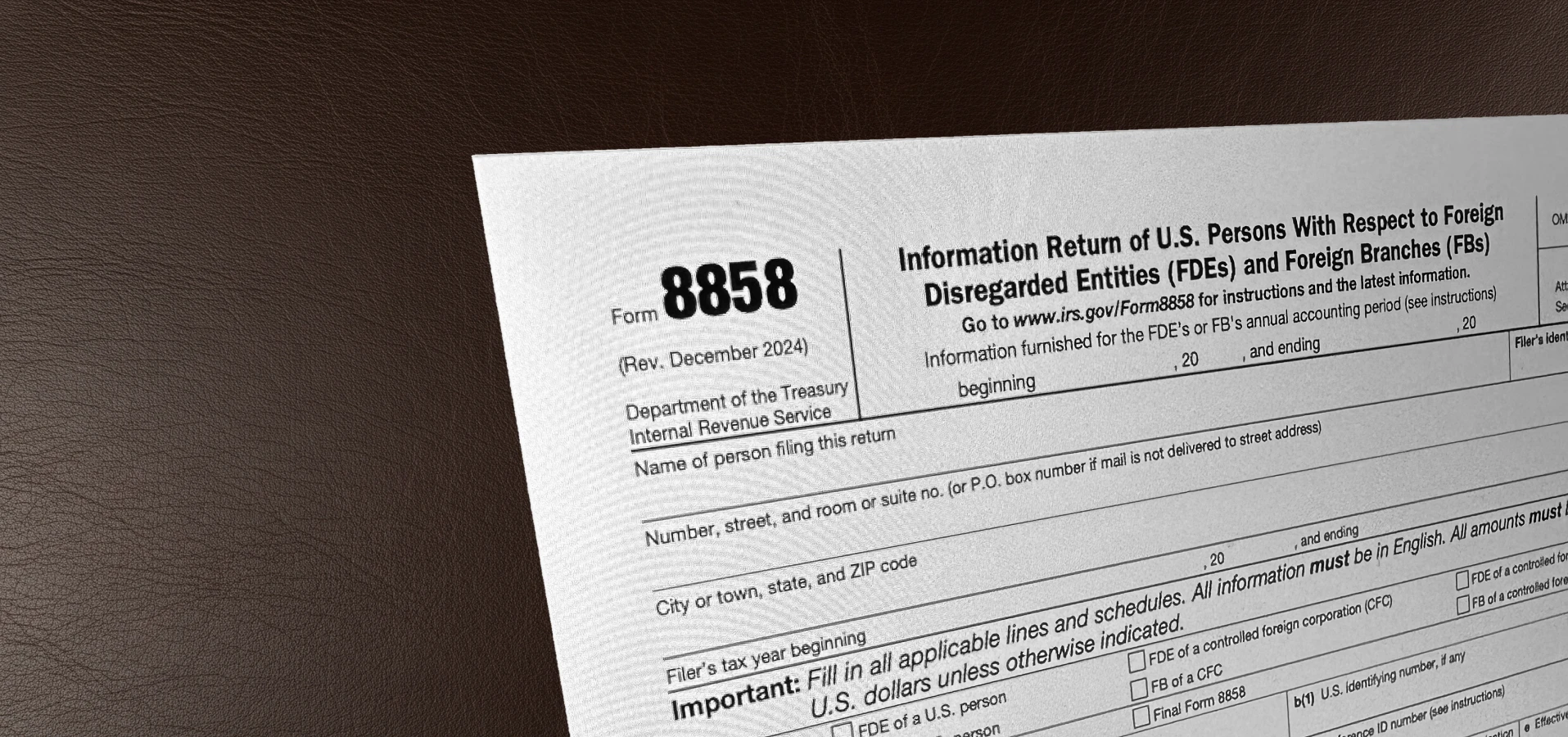If your business touches anything offshore – a foreign entity, a contractor you pay overseas, or even a shell company set up for IP – Form 8858 is not optional.
It’s a mandatory IRS filing that shows your ownership or control over a foreign disregarded entity or foreign branch. Skip it, file it late, or get it wrong—and the penalties stack up fast. $10,000 per entity, per year, minimum. You don’t want to learn about this form after an IRS notice lands in your inbox.
Let’s walk through exactly what Form 8858 does, who has to file it, and how to use it strategically to stay compliant while keeping your global operations smooth.
What Does Form 8858 Actually Do?
Form 8858 reports the activities of a foreign disregarded entity (FDE) or a foreign branch. Think of it as a schedule attached to your regular tax return—similar to Forms 5471 or 8865—but specific to foreign disregarded entities.
It doesn’t calculate tax directly. It’s informational. But “informational” doesn’t mean optional. The IRS uses it to track income, losses, assets, and operations that flow through your foreign entities.
If you don’t report it? They assume the worst.
Who Must File Form 8858?
Here’s the quick breakdown:
- U.S. persons (individuals, partnerships, corporations) that own 100% of a foreign disregarded entity (FDE)
- U.S. persons that operate a foreign branch
- U.S. owners of certain controlled foreign corporations (CFCs) that own an FDE
The ownership test is strict. If your U.S. LLC owns 100% of a foreign single-member entity—you’re on the hook. If your U.S. S-corp sets up a foreign branch for contracting or service delivery—same deal.
Even if the entity has no income, no activity, or no bank account, you still have to file.
What Is a Foreign Disregarded Entity (FDE)?
A foreign disregarded entity is any non-U.S. business that’s treated as part of its owner for U.S. tax purposes.
Let’s say your U.S. LLC owns 100% of a Belizean company. Belize treats it as a company. The IRS doesn’t. It disregards it. That means the IRS looks straight through it and treats you—the owner—as directly conducting the activity.
This structure is common in international consulting, remote staffing, offshore holding companies, and digital services.
And it’s exactly why the IRS demands Form 8858. They want to see through your disregarded veil.
How Is Form 8858 Different from Form 5471?
These two often get lumped together, but they report different things.
- Form 5471 is for controlled foreign corporations (CFCs) where U.S. persons own 50%+
- Form 8858 is for foreign disregarded entities or branches where a U.S. person owns 100%
Think of it this way:
- 5471 = you’re a shareholder in a foreign corporation
- 8858 = you’re the owner of something the IRS ignores as separate
One tracks foreign corp compliance. The other ties the activity directly to you.
What Is a Foreign Branch for U.S. Tax Purposes?
The IRS defines a foreign branch as an operation carried on by a U.S. person outside the United States that is either:
- Separate and clearly identifiable, and
- Maintains separate books and records
This applies to situations like:
- U.S. consultants working full-time from another country
- U.S. entities hiring and paying local staff abroad directly
- A U.S. service business registering a branch in a foreign country to avoid local withholding or taxes
If the IRS says it’s a branch, you’ll need to file Form 8858—even if you don’t call it that.
What Form Does a Self-Employed Person File?
If you’re a self-employed U.S. person and you operate a foreign disregarded entity or foreign branch, you file:
- Your usual Schedule C or Schedule E on Form 1040
- Plus Form 8858 attached to your return
This trips up a lot of digital nomads and solo consultants who incorporate offshore but don’t realize the IRS wants a full breakdown of what’s happening overseas.
What Happens If You Don’t File Form 8858?
Penalties. And they’re brutal.
- $10,000 per form per year for late or incomplete filings
- Additional $10,000 every 30 days after 90 days of IRS notice (up to $50,000 total)
- Loss of foreign tax credits
- Possible criminal exposure for willful neglect
This isn’t the kind of form you want to forget.
Even if you think the entity has no activity, file it anyway. Proactively. Correctly. Backed with documentation.
Common Scenarios That Trigger Form 8858 Filing
Let’s make this real. Here are four actual client-level scenarios that required 8858:
Scenario 1: U.S. LLC owns a foreign single-member entity
A U.S. software agency sets up a 100%-owned Estonian OÜ to run remote payroll. No local clients. No Estonian income tax. But the IRS sees it as a foreign disregarded entity. Form 8858 required.
Scenario 2: U.S. individual owns a foreign branch directly
An independent consultant works from Spain under a Spanish tax ID. No foreign entity, but a stable presence and local clients trigger foreign branch status. Form 8858 required.
Scenario 3: U.S. entity owns a CFC with a disregarded entity under it
A U.S. S-corp owns a Canadian corporation, which owns a Belizean subsidiary treated as a disregarded entity under Canadian law. That bottom-layer entity? Form 8858 required at the U.S. level.
Scenario 4: Using a foreign company for contractors or IP holding
A U.S. company sets up a Hong Kong limited company to hold IP and pay overseas contractors. No local sales. Still a foreign disregarded entity. Still requires Form 8858.
Key Schedules Inside Form 8858 That Actually Matter
Form 8858 looks like overkill—but only a few schedules carry real weight:
- Schedule C – Income Statement for the FDE/branch
- Schedule F – Balance Sheet
- Schedule H – Intercompany transactions
- Schedule M – Transactions between FDE/branch and filer
If you’ve got income or expenses running through that entity or branch, you’ll need to fill these out clearly. Don’t skip them. And don’t guess. The IRS has a long memory.
When Is Form 8858 Due?
It’s due at the same time as your federal return, including extensions.
- Individuals: due with Form 1040
- S-corps: due with Form 1120-S
- C-corps: due with Form 1120
- Partnerships: due with Form 1065
Miss the extension? The penalties apply—even if you filed everything else on time.
How to File Form 8858 Correctly (Without Guessing)
Most CPAs don’t do this form well. Many don’t do it at all. Here’s what we recommend:
- Determine ownership structure
- Clarify entity classification
- Gather financials
- File the form with your tax return
Attach it to your 1040, 1120, 1065, or 1120-S. Review for accuracy—especially intercompany transactions. Don’t wait until the last minute.
How Form 8858 Ties into Strategic Tax Planning
Here’s the real takeaway: Form 8858 isn’t just about compliance. It’s a window into how your offshore structure affects your entire tax profile.
Done right, foreign disregarded entities can:
- Support international contractor teams
- Hold IP for transfer pricing advantages
- Serve as global sales arms under a larger tax strategy
But if you don’t disclose it? Or file it wrong? The structure backfires.
Form 8858 is your way of showing the IRS: We know what we’re doing. Here’s the entity. Here’s how it flows. Nothing to hide.

Bottom Line: Stay Compliant. Stay Strategic.
Form 8858 isn’t just paperwork – it’s a signal to the IRS that you understand your global footprint and you’re playing by the rules.
If you have foreign disregarded entities or foreign branches and you’re not filing 8858, you’re gambling. And the IRS stacks the odds in their favor.
Get ahead of it. File clean. Document everything. And make sure it supports the larger tax strategy you’re building.
Otherwise, that “foreign entity” could turn into a very expensive mistake.
Need help? Reach out to our tax planning professionals for a free consultation.

